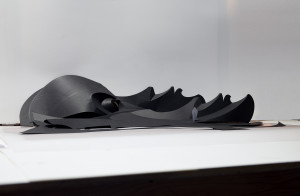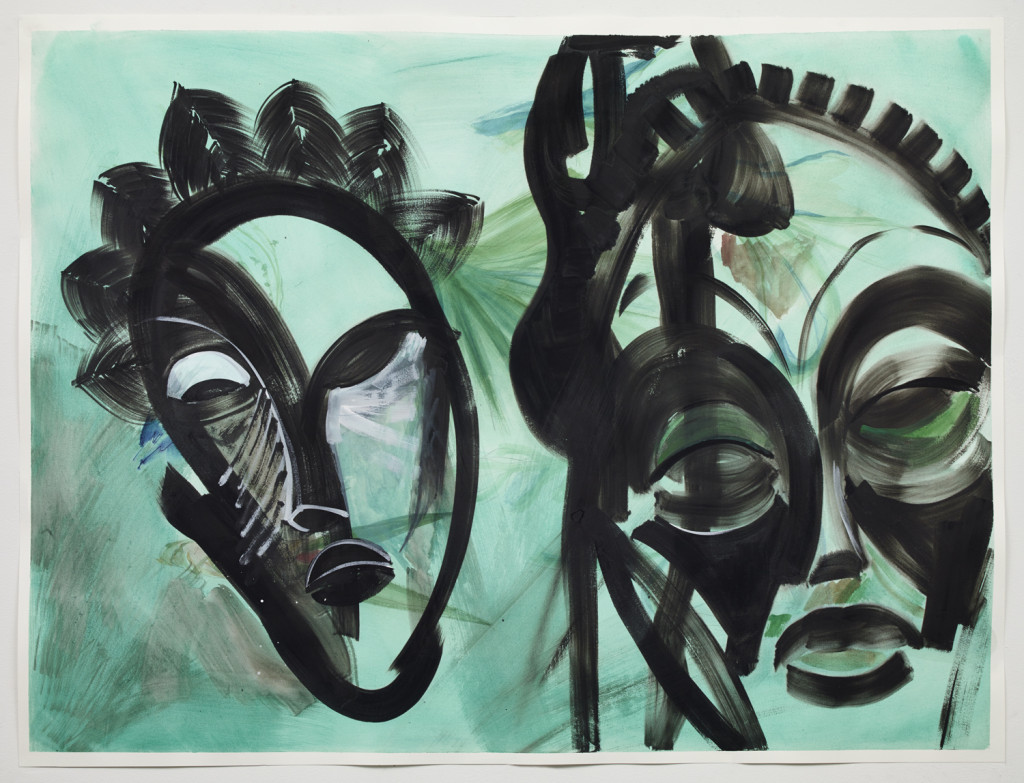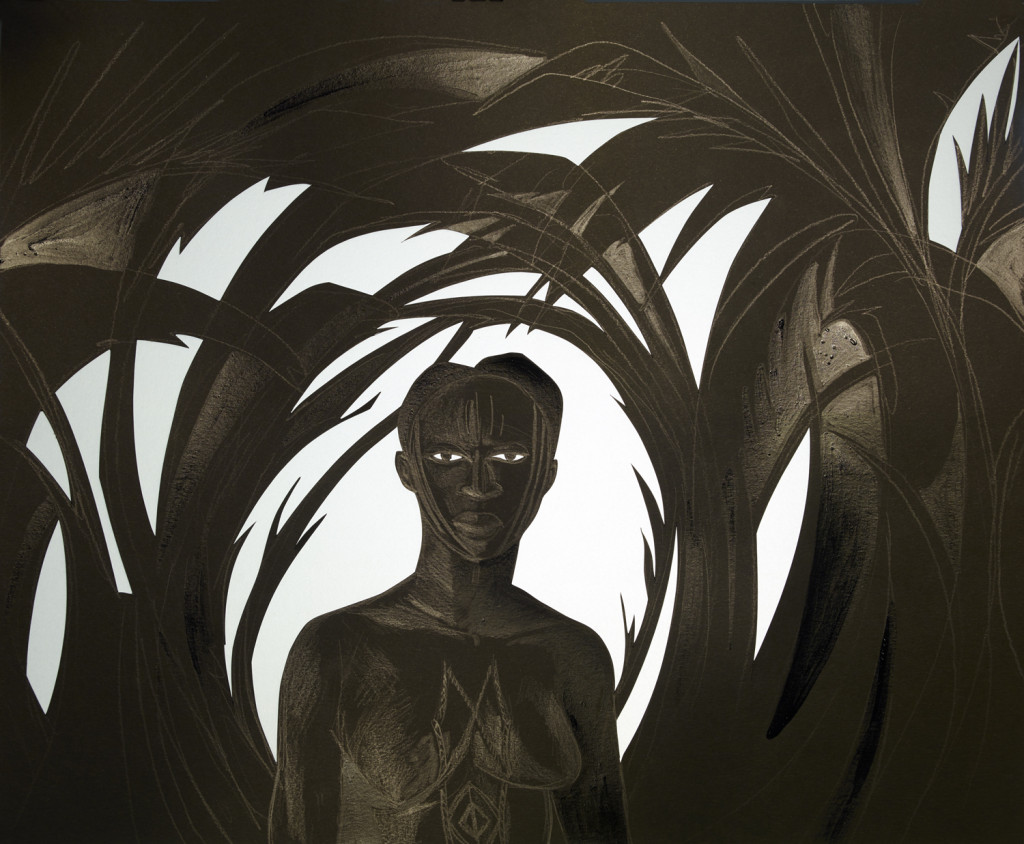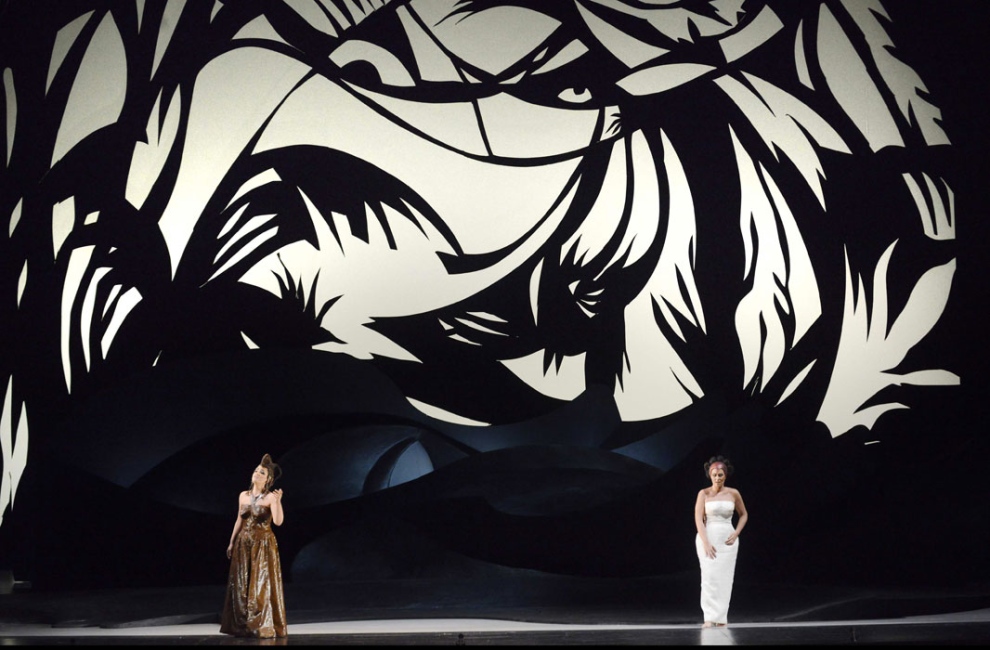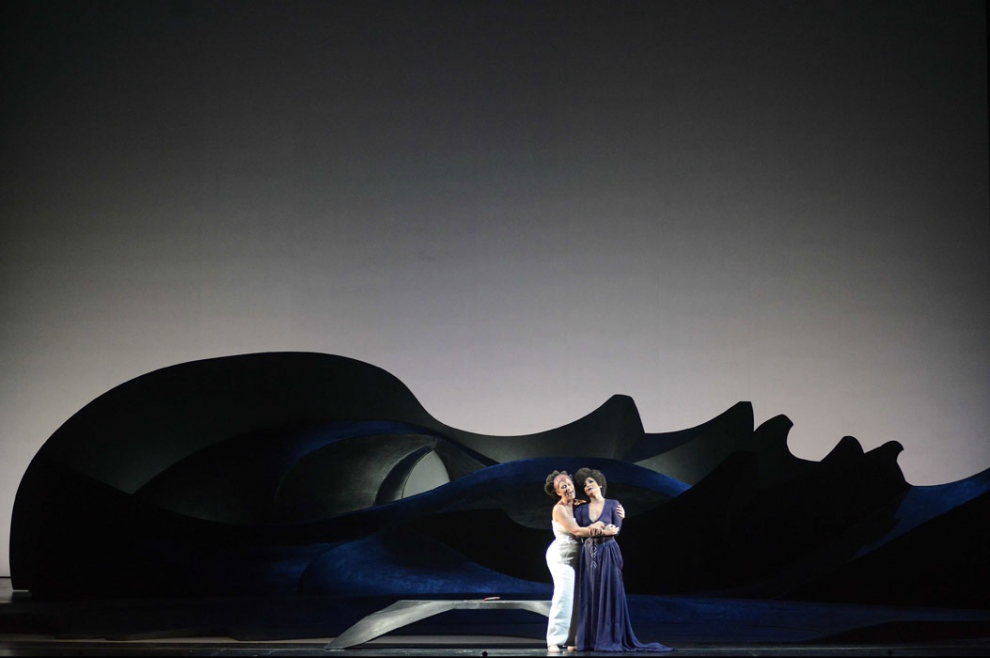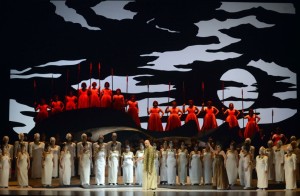
As many of the readers of this magazine know, I am an art critic, not an opera critic – or even an opera fan. My interest in this production was simple: I wanted to see what would happen when a formidable African American concept artist like Kara Walker confronted and re-interpreted a cornerstone of European culture.
Shelley Rice on Kara Walker’s stage design, set design and costumes for Bellini’s opera Norma as presented in Venice.
Photo Michele Crosera.
Gifts, Misappropriated: Kara Walker’s Norma
I was one of the lucky ones: my Teaching Assistant, Allison Young, was working on catalog research for the 2015 Venice Biennale, All the World’s Futures, when she happened to find out that Okwui Enwezor had commissioned Kara Walker to do the stage direction, set design and costumes for Vincenzo Bellini’s opera Norma, already on the schedule for late May and early June at the famous Teatro La Fenice. A collaboration between the Biennale and the Opera House, the work was billed as a “special project” of the bi-annual exhibition, and included a show of preparatory drawings on view in a special gallery in the extraordinary theatre (which was rebuilt and reopened in 2004 after a devastating fire destroyed it in 1996). Being an early bird, Allison managed to hook us up, months ago, with two tickets for the event the night of June 3, and made us the envy of our friends. As she had predicted, the show was sold out very soon after we made our purchase, once the details of the production were made public and tickets were offered for sale.
As many of the readers of this magazine know, I am an art critic, not an opera critic – or even an opera fan. My interest in this production was simple: I wanted to see what would happen when a formidable African American concept artist like Kara Walker confronted and re-interpreted a cornerstone of European culture. Moving from the art world into the opera world is not unprecedented; most recently and probably most publicly, South African artist William Kentridge has been very active in the theatre, designing The Magic Flute and The Nose as well as original signature works for the stage. But because Kara Walker is so deeply ideological, and so deeply identified with blackness, its culture and its history, I was curious to see what acts of appropriation – she calls them “misappropriation” – she would commit in re-presenting Bellini’s “gift.”
Production Model for Norma at Teatro La Fenice, Venice 2015.
The answer was evident as soon as we entered the theatre and saw the front curtain, the “grand drape” that hid the stage. On it, an obviously African woman – of monumental scale and naked above the waist – peered outwards, toward the public, with a steady gaze. Simultaneously growing from and anchoring the swirling, stylized branches of forest trees surrounding her, her dark skin was embedded within two-dimensional patterns of light that echoed the patterns on her incised skin. In other words, a message about the primacy of the black female body, in particular the African female body, and its profound relationship with nature, culture and cosmic rhythms greeted spectators as soon as they walked into the theatre. (This image was created by a projection, and it was also used on the poster announcing Walker’s Norma to the public. It represents, obviously, the iconic Norma of the artist’s imagination.) It was immediately clear that this African body would stand her ground; she was going to stare back at you, at the people sitting in the audience, unlike most of the nude female subjects – whatever their race — in European paintings and colonial photographs. This evening, in this theatre, Kara Walker was saying, the audience would experience, eye to eye, a face-to-face encounter with the Other.
It was of course also clear that the Others in question would not be the tribe of Druids, colonized by the Romans long ago, who were the stars of Bellini’s original script. Kara Walker, first and foremost, chose to highlight the fact that Bellini’s Norma, while having a secure place in the canon of European culture, is a deeply political story about unequal power relationships: between conquerors and colonized people, as well as between men and women. But it is not a story about battles, or action, or male bonding; in fact, very little actually happens in this play. The action unfolds through the bodies, interactions and emotions of the women on stage, who are snared within its political web. This overarching political scenario was made clear in Act I, Scene I by Bellini himself. The scene introduces the audience to the Druids, who meet in the forest with their High Priest Oroveso to vent their rage and express their desire to make war on the Romans who oppress them. Immediately after that, Roman Proconsul Pollione enters. Rather than political strategy, he discusses his love life with his aide Flavio. Pollione has fallen out of love with the High Priestess Norma, Oroveso’s daughter, with whom he has fathered two children in a secret affair. The plot revolves around his disenchantment, and the fact that his latest passion is a young virgin Priestess, the novice Adalgisa, who returns his love.
Sketch for Norma at Teatro La Fenice, Venice, 2015.
But this is not a simple soap opera plot, an everyday male midlife crisis, because Pollione is a colonial ruler and his “marriage” to Norma unites him to his nature oriented, mystical subjects, keeping peace and balance between two very different cultures and cosmologies. This aspect of the story is made very clear, very early in Bellini’s drama. Norma has enormous spiritual (ergo, in this situation, political) power, a power respected by her people and by the forces of the natural world they worship. Norma’s love for Pollione kept her social world in a tense equilibrium; peace depended literally on her female body, her patience and her emotional balance. Pollione’s betrayal — his love for the young priestess Adalgisa, and his obsessive desire to flee to Rome with her – would therefore by necessity have enormous diplomatic consequences, which everyone but him seems to understand instinctively.
Norma’s fury at his decision to leave (and presumably desert her and his two children) reaches a crescendo when she realizes (in a discussion with the novice Adalgisa, who comes to her for counsel and advice about her suitor, totally in the dark about Norma’s secret relationship with the Roman proconsul) that her lover has betrayed her with the young priestess. Emotions are unleashed: Norma’s anger stirs up the dark forces of the natural world, and Adalgisa is so horrified by Pollione’s duplicity that she rejects him. Pollione alone stays the course of his sexual obsession, obviously oblivious to (and uninterested in) the huge consequences – on the women, the temple, his children and the political balance of the region — of his actions. Literally, the future of the community is dependent on these two women, and their ability to rectify a situation within which neither has the power.
Act II is really about Norma’s reaction to these events: the murderous, horrified, frightened, tender and irrational emotions that a woman of her stature would have as she tries to retain the moral balance necessary to safeguard her family, her culture and the natural and mystical forces she channels. The curtain opens on her failed attempts to murder her sleeping children, to protect them from living in disgrace without a father – or perhaps even as slaves in Rome if their father chooses to bring them there. The two women meet and reconcile; Adalgisa refuses to go to Rome with Pollione, and offers to speak to him, to make him understand that he must return to Norma to keep their world in balance. Norma is assuaged, for a short time. A new commander is announced, who will replace the Proconsul when he leaves (we see very little of the Romans, they are like an omnipresent but invisible deus ex machina). Pollione refuses to return to Norma, and the High Priestess’ fury causes her to urge her people to attack the conquerors – and to kill both Adalgisa and the Proconsul — when he is brought in as a prisoner, for profaning the Temple. Pollione was caught trying to breach the Virgin Priestesses’ sanctuary in order to steal away his young love, a crime of transgression punishable by death under Druid law. The peace has ended, shipwrecked on the bodies of women and the rash and impulsive actions of a man. Norma tells her compatriots that a guilty priestess must also die – and to their horror makes it clear that the condemned woman must be herself, she who had broken her vows long ago and set this chain reaction in motion. Moved by her nobility, in love again, Pollione begs to share her fate, and after ascertaining the safekeeping of her children, Norma leads him to the pyre and the curtain falls.
Sketch for Norma at Teatro La Fenice, Venice, 2015.
Watching this supercharged drama unfold, it was hard for me not to think about the recent film Boyhood, directed by Richard Linklater. That movie is ostensibly about a boy, his youth and growth, but in reality it about his mother, the amazing Patricia Arquette, and the enormous trials and tribulations she undergoes, and burdens she shoulders, in order to simply raise her children in some kind of safe and secure environment. In the film, as in Norma, the personal becomes political – and the men, to a one, are deadbeats, whose actions and reactions create turmoil for those around them. This too was a primary thought for Kara Walker, who modeled Pollione on Pierre Savorgnan De Brazza, an Italian explorer – charming and reckless, accused by Africans of raping young women – who colonized Central Africa for the French government in the late 19th century. A foppish man, a functionary (“That’s the thing that gives this colonialized country its tragedy,” Walker wrote in her notes. “We are conquered by that? And Norma, her inherent flaw, seduced by Him?”), de Brazza, like Pollione is, in Walker’s words, “both laughable and extremely dangerous.” In Walker’s version of the story, Norma’s consort arrived onstage in flamboyantly North African clothing: khakis and boots adorned with an Arab turban and beard. Coming straight out of Lawrence of Arabia rather than Bellini, Pollione’s colonial costume made the audience gasp audibly when he appeared. Like the African woman – the Norma archetype – staring out at us from the grand drape, the actor playing the Proconsul located the drama of Walker’s opera by embodying it.
This conflation – of the Druids and colonized Africans, of Pollione and de Brazza – makes manifest Walker’s reinterpretation (“misappropriation”) of Bellini’s Norma. The artist made it clear, as soon as the audience entered the theatre, that her rendition of the opera is not about Druids, it is about Africans, and it is set in a Central African colony around the early 1900s. (Using Gabon masks and colonial photographs as models, Walker once again located the action by visualizing it.) The actors in her production, like Bellini’s, are “hybrid fantasies of the Noble Savage, Others,” and the sets are stylized forests and landscapes – pastiches of forms uniting Kara Walker’s flat silhouette style, the European “misappropriation” of African art in modernism and the blocky, sculptural masks of Central Africa. This is most evident, and most successful, in the artist’s amazing and protean stage set. Simple shapes, usually black in color though not always, outline the landscape. But the major landmass upon and around which all the action takes place resembles a Gabon mask of a woman’s face. Colors might morph depending on the light; skies might flash red or forests run rampant in stunning silhouettes projected as backdrops, making the mood and the scene more complex and dynamic. Actions of groups or individuals give different meanings to the sinuous and polysemous shapes on the stage. But the African female body is, literally and always, the ground upon which all the action in this opera unfolds.
Photo Michele Crosera.
And this, of course, is the point: all family ties, all of Nature, the spirit world and human politics ultimately rest on the challenges that face the two women on stage. One of them is young and fresh; the other is older, and deeply enmeshed in life’s obligations. One of them – Adalgisa – seemed to this viewer to be more symbolically African than the other. She embodied, in her hair and clothing, a closer resemblance to the sculptural forms of a Gabon mask — a signifying chain that for me at least encouraged, in fact demanded, a highly racialized interpretation of the story. The future of this colony evidently depended on what happened to the black female body – but that body was lying on the ground being walked upon by men during the whole production, and was vulnerable to being forcibly grabbed even during prayer time in the Temple. This is powerful stuff, and Walker’s transposition of the story adds immeasurable contemporary relevance to Bellini’s original tale – making its tragic lessons available to the present, to the future, to us all.
For all of these reasons, Kara Walker’s Norma is a great success, and an eye opening interpretation that both adds to and subverts Old World history and culture. Her decision to focus on the African context shatters the proscenium wall that separates European audiences from their own history and culture. Like Okwui Enwezor’s Venice Biennale, Walker’s opera insists on re-inserting the disappeared ones into the histories (and futures) of the Continent, and does so not by storming the house but by pointing out the shared dilemmas, common languages and “intense proximities” (to quote Enwezor) that affect us all.
Photo Michele Crosera.
The only negative thing I can say about Teatro La Fenice’s production of Norma involves the costumes, which might have been based on African sculptures and colonial photographs but which were, in fact, confusing for the audience. Guards in skirts carrying spears were legible to me as stylized representations of 19th century tribal warriors only late in the play, when they assembled; before that time, they just seemed weird, a bit kinky. In the absence of (the politically incorrect) the use of blackface, odd hairdos and outfits on white actors read less as African and more as some hybrid of a Noble Savage, a vacillation that dampened the tremendous signifying power of the other aspects of the production. Needless to say, “misappropriating” European singers and actors to represent colonized Africans is a challenge in this day and age, and to its great credit Walker’s staging made that challenge abundantly clear. There are many lessons to be learned from this wonderful and complex work, and I can only hope that this artist’s pointed and pertinent dialogue with our past, present and future will continue to provoke audiences on the shores of a few other continents.
Shelley Rice is an Arts Professor from New York. Joint appointment between the Department of Photography and Imaging and the Department of Art History of New York University. She published several books on photography.
Copyright 2015 Shelley Rice

